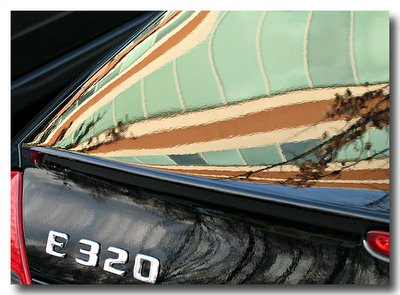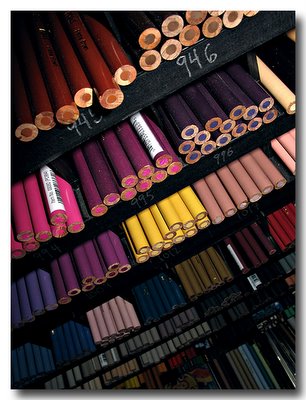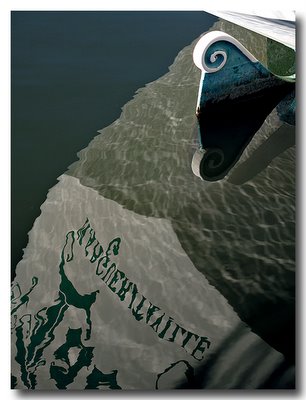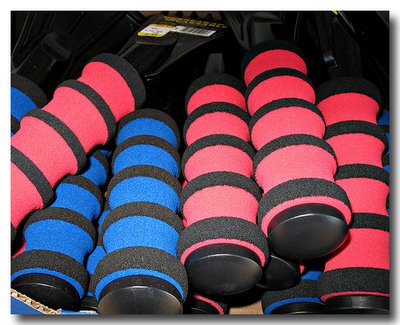Tuesday, January 31, 2006
More Canon A620 Results
 My experience with the new Canon A620 continues to be very satisfying.
My experience with the new Canon A620 continues to be very satisfying. One of the things mentioned in a number of the A620 reviews was a tendancy towards excess contrast and burnt-out highlights. I haven't really found that to be a problem so far.
Speaking of highlights, although the A620 does have an option of displaying a histogram right after an exposure, one thing I do miss is that it doesn't blink the areas in the photo where highlights are clipped. This is something that has become standard on DSLRs and higher-end digicams, such as the Canon G-series.
 Something else I haven't mentioned is speed. Speed of operation, that is. The A620 has the newer Canon DIGIC-II image processing chip, which is supposed to be much faster than the original DIGIC. As promised, my experience has been that wake-up time and shot-to-shot time is indeed very fast - actually better than my Digital Rebel (which still used the old DIGIC chip.) Part of the performance I've seen may be due to the RiTek 66x 1GB SD Card that I bought with the camera. With the Digital Rebel, I've been using standard old rotgut CF cards from PNY and SanDisk. One of my next purchases will be a faster card for the Rebel.
Something else I haven't mentioned is speed. Speed of operation, that is. The A620 has the newer Canon DIGIC-II image processing chip, which is supposed to be much faster than the original DIGIC. As promised, my experience has been that wake-up time and shot-to-shot time is indeed very fast - actually better than my Digital Rebel (which still used the old DIGIC chip.) Part of the performance I've seen may be due to the RiTek 66x 1GB SD Card that I bought with the camera. With the Digital Rebel, I've been using standard old rotgut CF cards from PNY and SanDisk. One of my next purchases will be a faster card for the Rebel.My Camera History, Part Deux
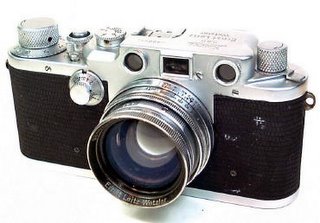
After college, I came back to Batimore, where I got my first engineering job, and where I lived for four years, until 1975.
On a day trip to NYC in late summer of 1973, I bought a Leica IIIc at Olden's, along with a Canon Seranar 50mm f/1.8 lens. With 2 or 3 rolls of Plus-X in my pocket, I was suddenly a Leica photographer, in the company of Cartier-Bresson and Eisenstadt. I had parked the car in Hoboken, and after returning there, I sneaked a shot of this gentleman reading his Daily News in the Erie-Lackawanna terminal.
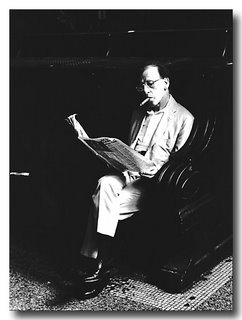 That Leica, when I bought it, was already 33 years old, but it was a thing of beauty. Compared to my Nikon, especially with its heavy and clunky Photomic T finder, it was a featherweight, and a pleasure to carry around. For some reason, compared to an SLR, the rangefinder mechanism and all the fine knurling on the various knobs gave it a feeling of watch-like precision. It may be a guy thing, but I found myself often picking it up at odd times and playing with it - not shooting pictures, just looking through the viewfinder and rangefinder (two separate windows in the old screw-mount Leicas!) and focusing it, and dry-firing it.
That Leica, when I bought it, was already 33 years old, but it was a thing of beauty. Compared to my Nikon, especially with its heavy and clunky Photomic T finder, it was a featherweight, and a pleasure to carry around. For some reason, compared to an SLR, the rangefinder mechanism and all the fine knurling on the various knobs gave it a feeling of watch-like precision. It may be a guy thing, but I found myself often picking it up at odd times and playing with it - not shooting pictures, just looking through the viewfinder and rangefinder (two separate windows in the old screw-mount Leicas!) and focusing it, and dry-firing it. The Serenar was a really excellent lens, but I had really wanted a Leica lens so as to be more "authentic." A year after buying the camera, I purchased a near-mint collapsible Summicron 50mm f/2.0. I wasn't disappointed, as this turned out the be the best lens I've ever owned prior to the digital age. Besides its amazing optical performance, it was also a better physical match for the small camera than the heavy Serenar. With the Summicron collapsed, I could slip the whole package into a coat pocket.
The Serenar was a really excellent lens, but I had really wanted a Leica lens so as to be more "authentic." A year after buying the camera, I purchased a near-mint collapsible Summicron 50mm f/2.0. I wasn't disappointed, as this turned out the be the best lens I've ever owned prior to the digital age. Besides its amazing optical performance, it was also a better physical match for the small camera than the heavy Serenar. With the Summicron collapsed, I could slip the whole package into a coat pocket.Here's another "Man on Bench" shot, taken in New York's Central Park, September 1974, with the Summicron. I was living in pre-Urban Redevelopment downtown Baltimore at the time, which seemed pretty boring to me, so I tried to get up to New York City a few times a year for picture opportunities.
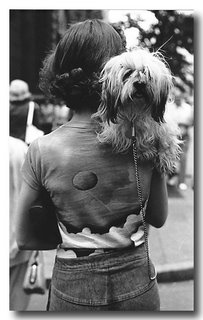 And here's one to show that I'm not afraid to get right up close to a subject and look him in the face! Check out the classic mid-'70's painted t-shirt and slightly pre-disco hairdo. This shot taken on Madison Ave in NYC, August 1974.
And here's one to show that I'm not afraid to get right up close to a subject and look him in the face! Check out the classic mid-'70's painted t-shirt and slightly pre-disco hairdo. This shot taken on Madison Ave in NYC, August 1974.Like these photos here, most of what I took with the Leica was black & white. After Roger's thorough training and several years of experience developing and printing B&W during college, I wouldn't let anyone else develop or print my negatives. During those first post-college years, my darkroom was a tiny hallway between the bathroom, bedroom, and living room in my one-bedroom apartment. There was a door to each room, so I just closed the ones to the bedroom and living room, set up a table in the hallway for my enlarger and trays, stuffed towels under the closed doors to block out stray light, and I was in business.
Just one more Leica photo for now, this one from the time after I had moved to Manhattan to work for GE....
 Rue Foyatier, this oft-photographed stairs, climbs up the Butte Montmartre in Paris, ending near Sacre Couer basillica, the highest point in the city. It was a soggy, overcast day, and I wanted a somber, lonely look. I waited with my Leica IIIc and this solitary lady obliged me by starting the long climb upward. December 23, 1977.
Rue Foyatier, this oft-photographed stairs, climbs up the Butte Montmartre in Paris, ending near Sacre Couer basillica, the highest point in the city. It was a soggy, overcast day, and I wanted a somber, lonely look. I waited with my Leica IIIc and this solitary lady obliged me by starting the long climb upward. December 23, 1977.And here's a shocker... the other day, I used Google Image Search to Google "Rue Foyatier", and of all the photos in cyberspace, this one is the first one!
Monday, January 30, 2006
My Camera History
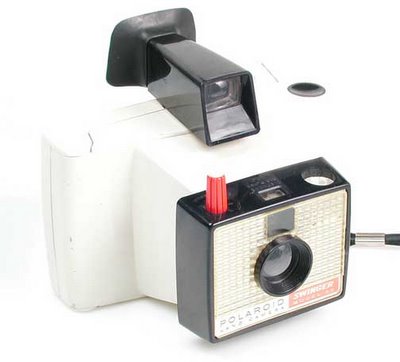
I was reading Dave Beckerman's blog (aka, The Mother of All Photo Blogs) the other day when I noticed the Photography Articles menu item. One of Dave's articles was called "Camera Addiction", sort of his camera history, and it struck a familiar chord with me.
So I thought, why not give my own history of camera addiction?
At age 17, it was a swinger that got me started.
Well, to be precise, it was a Swinger - a gray plastic Polaroid Swinger.
The camera was a very thoughtful high school graduation gift from my father's Cousin Ellen and her husband, the late Harold Siegel. I even remember the date - June 12, 1967 - the sixth day of the Six Day War - my parents had invited some family and friends to dinner in honor of my graduation.
Our genuine fear of a week earlier that something terrible was about to happen to Israel had been replaced by the elation of a complete victory for the Jewish State, and that added to the happiness of the evening.
I hadn't expected this wonderful gift, but I was genuinely delighted with the Swinger. The next day, I loaded up with the roll of film the Siegels had included and became a photographer.
The Swinger took a smaller version of what was then the regular roll film pack for Polaroid cameras. When you looked through the finder, part of what you would see was an indicator that said either "No" or "Yes." If you turned the red collar around the tall white shutter button, assuming that there was enough light for a successful photo, the "No" would eventually morph into "Yes," which meant that you had adjusted the exposure properly.
I realize now that it was what's called an extinction photometer - but a pretty effective exposure assistant nonetheless.
Swinger came with a manual, but you really didn't need it - Polaroid had a jingle-equipped commercial that told you all you need to know about how to use the camera - and the aggressive advertising campaign caused that commercial to also permanently embedded the price in my brain... "it's only nineteen dollars and ninety-five!" Hey, $19.95 was nothing to sneeze at to a 17-year-old in 1967.
The great thing about that little Swinger is that it whet my appetite for being able to do more with photography. I asked my friend Roger, who I knew was an avid amateur photographer - he had a Pentax H1a single-lens reflex, which at the time, seemed to me a magical mystery marvel of technology.
Roger showed me all about shutter speeds, f-stops, and focusing, at which point I dug out of a dusty bureau drawer my Dad's "real" camera, a Kodak Retina 1 (Type 010). Sure enough, there were the shutter speeds, there was the f-stop control, and here was a scale, in meters, for focusing. And by scale, I mean just that - this model of the Retina was a "scale-focuser", which means no rangefinder or other focusing aid - you have to use your calibrated eyeballs. But it had a pretty decent Schneider-Kreuznach 50mm f/3.5 lens, and not having a rangefinder also forced me to learn about hypefocal distance and use of the camera's depth-of-field scale. With Roger's tutelage, I soon was taking "real" photos with this "real" camera. Roger even gave me an old GE DW-48 light meter, and so I was in business.
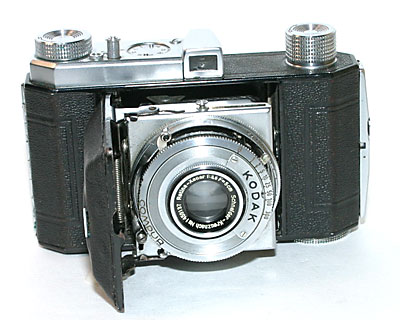
Roger and his dad had built a nice darkroom in their basement, and during that summer, they often invited me over to use it. The first time I saw one of my photos starting to "come up" in the developer tray under the safelight, I was hooked.
That fall, I started college at Stevens Institute of Technology in Hoboken, NJ. I joined the camera club, hung out with other photo enthusiasts, and made good use of the well-equipped darkroom that was available to us. Being a 35-cent, 15-minute ride from Manhattan didn't hurt either, as I was presented with plenty of subject matter.
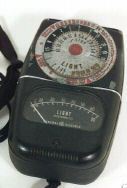 During the school year, I became good friends with my classmate Rich Schnabolk, who was a more advanced photographer than me. Rich actually had an SLR, albeit a Kowa SE, which I used to rib him about. Nevertheless, I wasn't too proud to use the Kowa and Rich was a good enough sport to lend it to me from time to time. And from humble beginnings... that Kowa made me lust after a "real" camera, that is, an SLR.
During the school year, I became good friends with my classmate Rich Schnabolk, who was a more advanced photographer than me. Rich actually had an SLR, albeit a Kowa SE, which I used to rib him about. Nevertheless, I wasn't too proud to use the Kowa and Rich was a good enough sport to lend it to me from time to time. And from humble beginnings... that Kowa made me lust after a "real" camera, that is, an SLR.During the summer of 1968, I worked at a photo store nearby. The owner had just bought a new Nikon F Photomic Tn, and offered me his 3-year-old Nikon F Photomic T at a very cheap price. And suddenly, I was a big-time Nikon photographer!
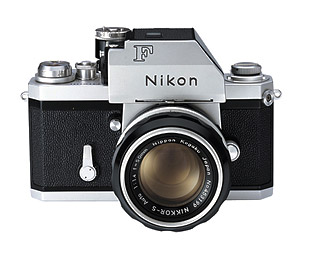 Back at college, I was a yearbook photographer, then photography editor in my junior year. We had bought a Yashica Mat 124 TLR that year, and digging around I found an old Crown Graphic 4x5 press camera that hadn't been used in years. I took both of them home with me during the summer, and I made good use of the TLR as a dog photographer (or, as Mom used to call me, Photographer to the Dogs.
Back at college, I was a yearbook photographer, then photography editor in my junior year. We had bought a Yashica Mat 124 TLR that year, and digging around I found an old Crown Graphic 4x5 press camera that hadn't been used in years. I took both of them home with me during the summer, and I made good use of the TLR as a dog photographer (or, as Mom used to call me, Photographer to the Dogs.Post-college cameras coming soon....
Tuesday, January 24, 2006
BIG Prints from Canon A620?...
 Sure!
Sure!Here are two prints I made this weekend. The slight cropping I did on the vertical photo resulted in a 12-1/2" x 17" print, while the horizontal shot stretched to 12-1/2" x 18-1/2", which is a big as I make 'em on my 13x19 Canon i9900 printer.
The prints are excellent - good enough quality that I would offer them for sale. They're certainly better than anything that I was able to get printed in my youth from Kodachrome or Ektachrome slides.
I also made a 12-1/2" x 17" print of Red Boat in Fog, which I matted and framed - and I've already had some people express interest in buying it.
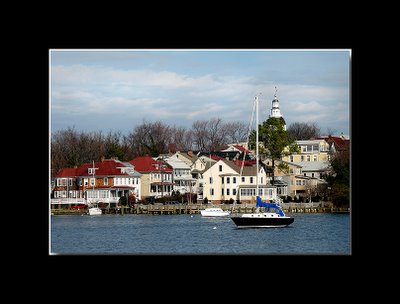 Would I say the large prints are as good as those from a DSLR, like my Digital Rebel? Well, not entirely. If you put your nose up to the print and look closely at evenly-toned areas, like clear sky, you'll see more noise in the A620 prints. But at normal viewing distances, it isn't a problem for many photos.
Would I say the large prints are as good as those from a DSLR, like my Digital Rebel? Well, not entirely. If you put your nose up to the print and look closely at evenly-toned areas, like clear sky, you'll see more noise in the A620 prints. But at normal viewing distances, it isn't a problem for many photos.For prints like the two shown here, there is a very small ratio of evenly-toned areas to highly-detailed areas, and the highly-detailed areas make up the main subject, so your eye doesn't tend to go to any areas that might be noisy. In a photo like Margueritaville, however, a large part of the picture is of the sort that shows noise - and it is more obvious in that photo - you can see it in the water. Whether it's too much noise will depend on the viewer and other subjective matters - for example, the boat's owner probably wouldn't mind very much.
My overall verdict is that the Canon A620 is certainly capable of making images that can be sucessfully printed at 13x19. The key is sticking to ISO 50 - maybe ISO 100 - and watching out for large, evenly-toned areas that might show a lot of noise. The bottom line is that I'm very happy with the A620 - it fits the bill for what I was looking for... a take-along-anywhere-and-everywhere camera that can also provide big prints.
Friday, January 20, 2006
A Grateful Immigrant
 Fifty-five years ago today, my family came to America, bringing me, just shy of my first birthday, with them.
Fifty-five years ago today, my family came to America, bringing me, just shy of my first birthday, with them.I won't go through the story again, but if you like, you can see it here.
I just wanted to say that I am grateful to the United States of America and to its generous citizens for bringing us here.
I am grateful for the crew of the troopship that carried us here, the USNS General C. H. Muir, and I am grateful to the staff at Ellis Island in late January 1951, who housed and fed Mom and me (I caught measles on the boat and had to be quarantined for 10 days) and took care of my medical needs.
Greetings to all my brother and sister immigrants! We've adopted and have been adopted into a pretty amazing and wonderful family.
Tuesday, January 17, 2006
Hangin' In There (cont'd)...

Thanks to a suggestion by the talented Warren T and others, here is a composite of the 10 photos that I sold to the mortgage company.
Sorry for the small sizes - you can see most of them more clearly in either my "Annapolis" portfolio or my "Baltimore" portfolio on Usefilm.com.
Monday, January 16, 2006
Hangin' In There...
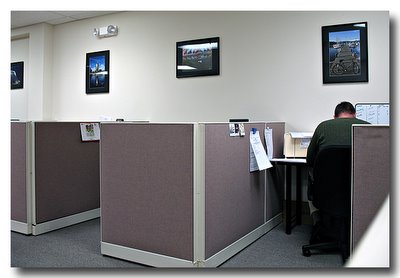
Here are, in situ, some of the ten photos that a local mortgage company bought from me to decorate their new office. They are all 13x19 prints made on my Canon i9900 printer from images out of my Canon Digital Rebel.
That $25 course I took last winter at a local craft shop on how to cut my own mats came in handy on this job (they wanted framed and matted photos.)
I have to say, with all due modesty, that the prints do look pretty good. One thing that still amazes and delights me is that, at least as far as color prints go, I can get far better results from a digital image out of my DSLR than I ever was able to get with prints from 35mm transparencies.
Editor's Note: Based on a comment by one of our more astute readers, it's clear that the writer of this post did not clearly explain what's going on here. It should be noted that what was sold was 10 large, framed photographs. The photo that accompanies this post shows a few of those photographs after they were hung in the mortgage company office.
We have threatened to reduce his salary if he continues to write in this foggy manner.
Friday, January 13, 2006
Canon A620 - My First 150 Shots
Spending the last two weeks with a digicam after over two years of using a DSLR has been both jarring and rewarding.
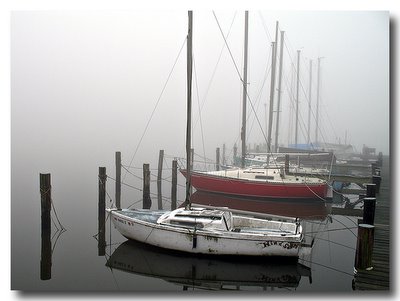 I'd forgotten how much I've been taking for granted with my DSLR. ISO 400 is probably the most significant. For two years, I've been running around taking photos with the resolution of Kodachrome 25 and the effective film speed of Tri-X. What a deal! The relatively large (22.7 mm x 15.1 mm) sensor of the Digital Rebel has, relatively speaking, large pixel sites. Large pixels translates to less noise. On the other hand, the Canon A620 has about 17% more pixels than the Digital Rebel crammed into a little 7.2 mm x 5.3 mm chip - that's one-ninth the area of the DSLR sensor. So while you can crank the A620 up to ISO 400, you don't want to.
I'd forgotten how much I've been taking for granted with my DSLR. ISO 400 is probably the most significant. For two years, I've been running around taking photos with the resolution of Kodachrome 25 and the effective film speed of Tri-X. What a deal! The relatively large (22.7 mm x 15.1 mm) sensor of the Digital Rebel has, relatively speaking, large pixel sites. Large pixels translates to less noise. On the other hand, the Canon A620 has about 17% more pixels than the Digital Rebel crammed into a little 7.2 mm x 5.3 mm chip - that's one-ninth the area of the DSLR sensor. So while you can crank the A620 up to ISO 400, you don't want to.
I've been sticking to ISO 50 or 100, and that means that at times, I get the little "shaky camera" icon on the LCD screen, indicating that the shutter speed is kinda low.
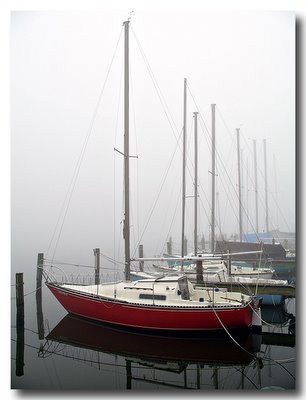 The other thing that's come to me is that for eighty percent or so of my picture-taking, looking through an SLR viewfinder beats looking at an LCD screen. Not that the A620's screen isn't excellent - it really is. As these things go, it's big, bright, and has that twisty-flexy feature for those shots where you want to use it as a waist-level finder or shoot over the heads of the crowd. But in bright sunlight, it still gets washed out and hard to see. Also, holding up a camera and looking at its back is just not the steadiest way to hold a camera.
The other thing that's come to me is that for eighty percent or so of my picture-taking, looking through an SLR viewfinder beats looking at an LCD screen. Not that the A620's screen isn't excellent - it really is. As these things go, it's big, bright, and has that twisty-flexy feature for those shots where you want to use it as a waist-level finder or shoot over the heads of the crowd. But in bright sunlight, it still gets washed out and hard to see. Also, holding up a camera and looking at its back is just not the steadiest way to hold a camera.
And so far, that's about it for the downside. Other than these two things, I really like the A620. Also, keep in mind that what I've said so far applies to small-sensor digicams in general and doesn't represent a shortcoming of the A620 itself.
Canon's designers did a great job of making the A620 easy to operate. Pretty much anything you would want to do on a frequent basis is easy to get at with a press of your right thumb of one of the logically laid-out controls on the camera back.
There's even a "Custom" mode that allows you to instantly get to your favorite settings by turning the mode dial to "C." For example, the "rock-and-roll" shooting mode (hold down the shutter button and it keeps taking pictures) normally resets to single-shot mode when you turn the camera off and on. But you can save the multi-shot mode as one of settings for your Custom mode (which is what I do.) I'm sure this was mentioned in one of the several reviews I read, but I don't remember seeing it - so I was pleasantly surprised by this feature.
The camera provides for lots of flexibility for those of us who think of ourselves as real photographers. In aperture-priority mode, which I use, you can easily set exposure compensation, flash exposure compensation, change auto-focus zones, and even manually focus the lens.
One of my favorite features is the option to display a grid on the LCD that divides the frame into thirds, horizontally and vertically. Sort of a rule-of-thirds detector, and it helps keep straight lines straight, when that's what you want. I wish the Canon DSLRs had this (I think Nikon D70 does?)
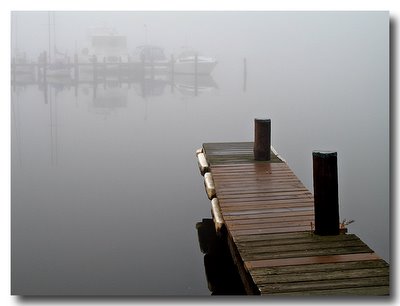 Of course, the main reason I bought the camera is that it's small enough to take pretty much everywhere. So far, I've done just that every day since I got the camera. I either put it in a jacket pocket or shove it into an old 1983 Canon Sure-Shot case and throw it into the bag I carry with me to work.
Of course, the main reason I bought the camera is that it's small enough to take pretty much everywhere. So far, I've done just that every day since I got the camera. I either put it in a jacket pocket or shove it into an old 1983 Canon Sure-Shot case and throw it into the bag I carry with me to work.
And it pays - today I stopped by the Severn River on the way to work and, in the morning fog, took the pictures you see here today.
In conclusion, so far, so good. I'll be using the A620 a lot over the next few weeks and will have more to say, especially about its ability to deliver big prints.
Stay tuned.
 I'd forgotten how much I've been taking for granted with my DSLR. ISO 400 is probably the most significant. For two years, I've been running around taking photos with the resolution of Kodachrome 25 and the effective film speed of Tri-X. What a deal! The relatively large (22.7 mm x 15.1 mm) sensor of the Digital Rebel has, relatively speaking, large pixel sites. Large pixels translates to less noise. On the other hand, the Canon A620 has about 17% more pixels than the Digital Rebel crammed into a little 7.2 mm x 5.3 mm chip - that's one-ninth the area of the DSLR sensor. So while you can crank the A620 up to ISO 400, you don't want to.
I'd forgotten how much I've been taking for granted with my DSLR. ISO 400 is probably the most significant. For two years, I've been running around taking photos with the resolution of Kodachrome 25 and the effective film speed of Tri-X. What a deal! The relatively large (22.7 mm x 15.1 mm) sensor of the Digital Rebel has, relatively speaking, large pixel sites. Large pixels translates to less noise. On the other hand, the Canon A620 has about 17% more pixels than the Digital Rebel crammed into a little 7.2 mm x 5.3 mm chip - that's one-ninth the area of the DSLR sensor. So while you can crank the A620 up to ISO 400, you don't want to.I've been sticking to ISO 50 or 100, and that means that at times, I get the little "shaky camera" icon on the LCD screen, indicating that the shutter speed is kinda low.
 The other thing that's come to me is that for eighty percent or so of my picture-taking, looking through an SLR viewfinder beats looking at an LCD screen. Not that the A620's screen isn't excellent - it really is. As these things go, it's big, bright, and has that twisty-flexy feature for those shots where you want to use it as a waist-level finder or shoot over the heads of the crowd. But in bright sunlight, it still gets washed out and hard to see. Also, holding up a camera and looking at its back is just not the steadiest way to hold a camera.
The other thing that's come to me is that for eighty percent or so of my picture-taking, looking through an SLR viewfinder beats looking at an LCD screen. Not that the A620's screen isn't excellent - it really is. As these things go, it's big, bright, and has that twisty-flexy feature for those shots where you want to use it as a waist-level finder or shoot over the heads of the crowd. But in bright sunlight, it still gets washed out and hard to see. Also, holding up a camera and looking at its back is just not the steadiest way to hold a camera.And so far, that's about it for the downside. Other than these two things, I really like the A620. Also, keep in mind that what I've said so far applies to small-sensor digicams in general and doesn't represent a shortcoming of the A620 itself.
Canon's designers did a great job of making the A620 easy to operate. Pretty much anything you would want to do on a frequent basis is easy to get at with a press of your right thumb of one of the logically laid-out controls on the camera back.
There's even a "Custom" mode that allows you to instantly get to your favorite settings by turning the mode dial to "C." For example, the "rock-and-roll" shooting mode (hold down the shutter button and it keeps taking pictures) normally resets to single-shot mode when you turn the camera off and on. But you can save the multi-shot mode as one of settings for your Custom mode (which is what I do.) I'm sure this was mentioned in one of the several reviews I read, but I don't remember seeing it - so I was pleasantly surprised by this feature.
The camera provides for lots of flexibility for those of us who think of ourselves as real photographers. In aperture-priority mode, which I use, you can easily set exposure compensation, flash exposure compensation, change auto-focus zones, and even manually focus the lens.
One of my favorite features is the option to display a grid on the LCD that divides the frame into thirds, horizontally and vertically. Sort of a rule-of-thirds detector, and it helps keep straight lines straight, when that's what you want. I wish the Canon DSLRs had this (I think Nikon D70 does?)
 Of course, the main reason I bought the camera is that it's small enough to take pretty much everywhere. So far, I've done just that every day since I got the camera. I either put it in a jacket pocket or shove it into an old 1983 Canon Sure-Shot case and throw it into the bag I carry with me to work.
Of course, the main reason I bought the camera is that it's small enough to take pretty much everywhere. So far, I've done just that every day since I got the camera. I either put it in a jacket pocket or shove it into an old 1983 Canon Sure-Shot case and throw it into the bag I carry with me to work.And it pays - today I stopped by the Severn River on the way to work and, in the morning fog, took the pictures you see here today.
In conclusion, so far, so good. I'll be using the A620 a lot over the next few weeks and will have more to say, especially about its ability to deliver big prints.
Stay tuned.
Thursday, January 12, 2006
Canon A620 Walking-Around Photos
Wednesday, January 04, 2006
Canon A620 Insta-Test
OK, it really isn't much of a test, but I got home late tonight to find my new Canon A620. These photos are the results of about 15 minutes of scientific testing - I just rested the camera on the shelf where I keep my Glorious Commie Cameras and snapped a few photos.
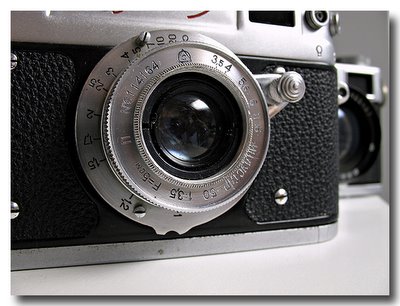
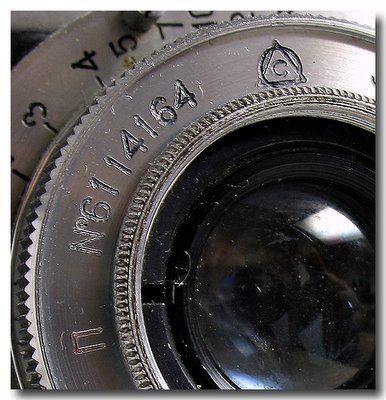
The second image is about 1/7 of the frame of the first photo. As far as resolution goes, this camera looks very promising.
I printed out a section of the photo, equivalent to about 12x17, on 8-1/2 x 11 photo paper, and at first glance, the quality is superb. It looks like good 11x14 and even 13x19 prints will be possible, under the right conditions, with this camera.
More to come soon, once I get to try it out in the real world. As of tomorrow, I start carrying the A620 with me pretty much everywhere I go.


The second image is about 1/7 of the frame of the first photo. As far as resolution goes, this camera looks very promising.
I printed out a section of the photo, equivalent to about 12x17, on 8-1/2 x 11 photo paper, and at first glance, the quality is superb. It looks like good 11x14 and even 13x19 prints will be possible, under the right conditions, with this camera.
More to come soon, once I get to try it out in the real world. As of tomorrow, I start carrying the A620 with me pretty much everywhere I go.
